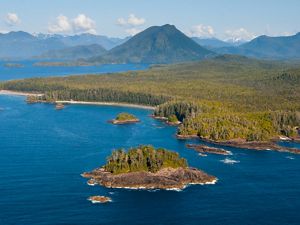About the Emerald Edge Network
Weaving a Network for Biocultural Stewardship
By Mariana Velez, Emerald Edge Network Director
We frequently say three things about the Emerald Edge: its 100 million acres of forests and islands are home to the largest remaining coastal temperate rainforest on Earth; these majestic lands, waters and wildlife are a global treasure of biodiversity; and its vast old-growth forests are one of the world’s best examples of a natural climate solution, storing 300 million metric tons of carbon a year, equivalent to the annual energy use of nearly 58 million homes.
But what truly ties these coastal landscapes together are the many Indigenous Peoples who have lived here and stewarded these lands since time immemorial. Indigenous First Nations, Alaska Natives and coastal Tribes have called this region home for millennia, connected through trade, language and familial relationships. These bonds were interrupted through colonialism and separation through the creation of borders and the dispossession of Indigenous lands, which in turn contributed to the loss of language, knowledge sharing and cultural practices. And yet, living traditions of land and water stewardship grounded in Indigenous and community values resist, persist and continue to define the vitality and well-being of this region.
The Emerald Edge Network, hosted by The Nature Conservancy and our Canadian affiliate, Nature United, seeks to realize Indigenous-led and ally-supported land and water stewardship by accelerating precedent-setting initiatives and building capacity, support and belonging between community leaders across colonial borders. This work is nested in a commitment to building long-term, reciprocal relationships with our Indigenous partners and learning how to stand in Right Relations to support cultural, economic and ecological well-being across the Emerald Edge.
Quote: Garrett Dalan

Our highest value proposition in the Emerald Edge is the Network. Bringing leaders together so they can build relationships is powerful. The energy and optimism of that relationship building rolls over into the work and makes projects look very different.
Expanding Our Hospitality
The Emerald Edge Network has a practice of welcoming leaders from other parts of the Pacific and the world to enrich and bring perspective to our whole-system initiative. Our work is nested in a global movement to be in Right Relations with our Indigenous partners and restore cultural practice and responsibility over territories.
Learn more about The Nature Conservancy’s and Nature United’s commitment to building long-term, trusting partnerships with Indigenous Peoples and local communities.
Biocultural Diversity
Upholds the inextricable link between cultural and biological diversity. It acknowledges that the diversity of life includes human cultures and languages, as well as how diversity and ecosystems have been historically co-produced and continue to evolve through place-based biophysical processes and customary landscape management. It recognizes the intimate connection between Indigenous knowledges, languages, practices and cultural protocols with the lands and waters which transcends stewardship and management and can also define governance, spirituality and law.
Our Approach
Acknowledging biocultural identity, the Emerald Edge Network centers and uplifts living cultures of stewardship grounded in Indigenous and community values. By bringing Indigenous and community leaders together, our network approach seeks to enhance regional coordination by:
- building capacity, support and belonging between leaders across colonial borders
- accelerating precedent setting projects and initiatives that realize Indigenous-led and ally-supported conservation
- supporting land-based learning exchanges between communities to increase knowledge sharing and strengthen the integrity of land and water stewardship
Since 2017, The Emerald Edge Network has engaged hundreds of Indigenous and community leaders and accelerated dozens of precedent-setting initiatives in the region through our biannual gatherings, targeted capacity-building workshops and land-based learning exchanges.
These cross-regional gatherings have been designed in collaboration with Reos Partners with an initial focus on building capacity for an experimental, collaborative and systems-thinking approach to strengthen Indigenous and community leadership as well as sustainable economic development across the Emerald Edge. Carefully designed and facilitated, these spaces center a relationship-first and humble-inquiry approach that not only lowers barriers to doing good work, but also fosters mutually respectful relationships between Indigenous and non-Indigenous participants.
Quote: Mariana Velez
There is an art to how we gather—based a little on network theory, a lot on careful design and very much based on meaningful connections.

In this values-based container, our practice of convening has produced key realizations that orient our commitment and accountability to supporting a relational network for Indigenous-led and ally-supported stewardship in the Emerald Edge, namely:
- We work to create generative spaces “free of urgency,” where partners can build capacity for collaboration and innovation, voice shared struggles and exchange experiential knowledge critical to accelerating precedent-setting initiatives in the region.
- A network approach releases inspiration and energy. It provides strength, clarity and support to the leaders we bring together and catalyzes emergent ideas and opportunities that otherwise remain unrealized.
- Foregrounding Indigenous knowledge and practice in how we gather and how we work requires moving at the speed of trust and centering healing as an intrinsic revitalization of land and water stewardship. This allows ceremony and cultural protocol to increasingly provide parameters to how we relate, listen and act. Active commitment is also required on the part of non-Indigenous participants and organizations to unlearning and acknowledging the harms of colonization (past and present) as we move toward respectful allyship.


The Network in Action
Quote: Mary Porter
Indigenous peoples on this continent are either landscape or seascape gardeners, and through this initiative I see The Nature Conservancy helping people tend those gardens again.
Gathering
In April 2024 in Portland, Ore, 50 Indigenous and community leaders gathered for a Network Project Accelerator, which is one of the formats we employ for our biannual gatherings. An Accelerator is an intensive Network engagement designed to foster innovation, relationship, visioning, experience-sharing and problem-solving. Indigenous- and community-led teams bring projects that can be anywhere in their development, from an idea to a full-fledged initiative. Facilitators and knowledge weavers—who are network guests that provide additional insight—help to advance, nudge and inspire projects to the next level, whatever that means to each team.
Accelerating Precedent-Setting Work
Another Network Accelerator gathering in 2019 in Vancouver, B.C., brought together Indigenous leaders from Southeast Alaska with representatives from Coast Funds, a successful model of Indigenous-led conservation finance in British Columbia, Canada. What started as an idea at this gathering—and inspired and adapted from Coast Funds—the attendees from Alaska went home to their communities and developed the Seacoast Trust. The Trust is a new and innovative initiative that is ensuring permanent funding for Indigenous-led conservation, community development and collective impact in the region through the Sustainable Southeast Partnership—and is helping inspire other Indigenous communities around the world.
Learning Exchange
After battling substance abuse in their community, local leaders from Kake in Southeast Alaska started a push for community healing, an intentional movement to address the trauma responses that can show up as substance-use disorder. In their effort to build a cultural healing center, community leaders from Kake traveled across the Pacific in 2023 to exchange stories and knowledge with Native Hawaiian groups leading similar efforts. Sponsored by the Emerald Edge Network, this learning exchange fostered an understanding of how healing the relationship with the land can help heal the relationship with oneself, and between people and within communities.
Quote: Crystal Yankawgé Nelson (Tlingit)
Connecting across the Pacific the way our ancestors did is one more step on the path to remembering who we are. When we reconnect across the borders constructed by settlers, we become more whole, which is the definition of healing—to make whole again.
Learn More
To learn more about the Emerald Edge Network and to become involved, please contact: Mariana Velez, Emerald Edge Network Director, mvelez@TNC.ORG
We Can’t Save Nature Without You
Sign up to receive regular updates from The Nature Conservancy.





